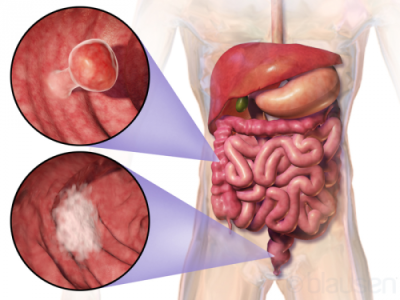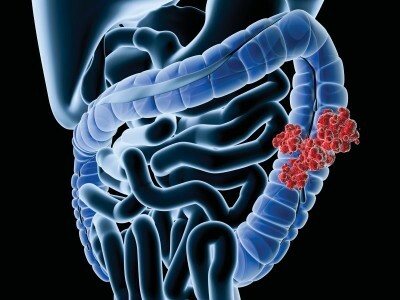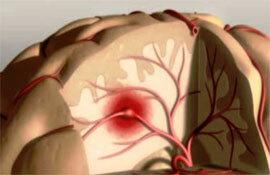1 The essence of the pathology
Intestinal cancer is a malignant tumor in the form of a modified glandular epithelium with predominant localization in the rectum and colon. Given the greatest prevalence, this type of oncology is most often referred to as colorectal cancer, i.e.the tumor encompasses the colon( column) with its four consecutive sections and a rectum or large intestine( rectum) in the pelvic region. In the small intestine and the cecum, oncology is recorded extremely rarely( no more than 1% of all cases of oncology of the intestine).

We recommend that you familiarize yourself with
- Signs of appendicitis in men
- Sigmoid colon
- What should I do with food poisoning?
- Effective agent for gastritis and gastric ulcer
Malignant neoplasms are distributed as follows in their localization: a rectal tumor( more than half of all cases), a sigmoid colon( almost 40%), a descending and ascending branch( 6-8%), in the transverse regionof the colon( 2-3%).At the same time in men the most common cancer of the rectum, and in women - different areas of the colon. Practically in 99% of oncology of the intestine is caused by the regeneration of intestinal polyps, which are benign in nature and consist of glandular tissue, which determines the most characteristic morphology of such cancer - adenocarcinoma. Tumors are detected at any age, but their incidence significantly increases in people over 45 years( with a peak at 65-70 years).
2 Etiology of
disease The etiology of intestinal cancer formation has not been fully established, but some reasons are generally accepted. An important role is played by nutrition. Excess of products with a predominance of fats and proteins of animal origin combined with hypodynamia significantly increases the risk of cancer. Conversely, the probability of pathology is significantly reduced when consuming food enriched with vegetable proteins, carbohydrates and fiber.
The most probable causes of oncology are associated with colonic polyposis( the most dangerous are diffuse and villous polyposis, Turco and Peitz-Egers-Touraine syndromes), gastrointestinal type pathologies( ulcerative colitis, Crohn's disease), metabolic diseases( diabetes mellitus).Influence of such pathologies on the onset of a malignant tumor as follows:
-
 IMPORTANT TO KNOW! Gastritis? Ulcer? To have a stomach ulcer not turned into cancer, drink a glass. ..Read the article & gt; & gt;
IMPORTANT TO KNOW! Gastritis? Ulcer? To have a stomach ulcer not turned into cancer, drink a glass. ..Read the article & gt; & gt;
- hemorrhoids;
- diverticula;
- intestinal obstruction in chronic form;
- fistula and anal fissure;
- pathology of the lower tract tracts.
To provoking factors should be attributed:
- genetic predisposition;
- bad habits( smoking, alcohol);
- improper power;
- toxic poisoning;
- mechanical damage and injury;
- stress;
- age changes.
4 Symptoms of the disease
Signs of bowel cancer depend on the location of the focus and the stage of development of pathology. When the cancer of the intestine arises, the symptoms of the tumor can not manifest themselves at all, but gradually increase in intensity as the disease progresses.
ADVICE FROM THE MAIN GASTROENTEROLOGIST
Korotov SV: "I can recommend only one remedy for the rapid treatment of Ulcer and Gastritis, which is now recommended by the Ministry of Health. .." Read testimonials & gt; & gt;

The first signs of cancer have an indeterminate and nonspecific character, which makes it difficult to differentiate from other diseases. There are the following symptoms of bowel cancer at an early stage:
- general weakness, malaise and fatigue;
- intestinal discomfort;
- pain in the abdomen in places of localization of the hearth;
- progressive weight loss;
- small, but stable increase in temperature;
- appearance of dark color of the stool, as well as blood traces or mucus in the feces;
- pallor of the skin;
- signs of an intestinal disorder( nausea, eructation, flatulence, unstable stool, heaviness in the stomach after eating).
Blood and mucous admixtures in feces are the most characteristic signs of oncology in the first stage in the absence of hemorrhoids. The initial manifestation is seen in the form of blood veins. The amount of blood in the stool increases with the progression of the disease. Blood selection can precede feces or go along with it. Mucus in the defeat of the rectum in its pure form is not secreted, but is usually mixed with blood.
Intestinal tumor during its progression manifests itself in different symptoms. The main signs of intestinal cancer are divided into several groups according to the nature of manifestation: toxic-anemic, enterocolitis, dyspeptic, obturation and pseudo-inflammatory symptoms.
The toxic-anemic group includes signs of mucosal integrity disorder, which causes intestinal infection to enter the bloodstream and leads to general intoxication of the body. The following symptoms are distinguished:
- weakness;
- headache;
- fast fatigue;
- joint pain;
- slight increase in temperature;
- anemia of the mucosa with its pallor;
- decrease in hemoglobin level in the blood;
- increase in blood density;
- changes in cardiac and respiratory rhythm.
In order to identify a tumor by these signs, it is necessary to check the presence of many diseases characterized by the same manifestations.
Symptoms of enterocolitis are caused by inflammation of the rectum, which in addition to severe intoxication causes intestinal dysfunction. Signs of this group are the following manifestations:
- fever with marked fever;
- diarrhea( sometimes, on the contrary, constipation);
- flatulence, bloating;
- pain in the abdomen after eating;
- disruption of rectum peristalsis;
- mucous, purulent and blood impurities in the feces.
In its manifestation, the symptoms of this group are similar to those of dysentery and other inflammatory pathologies of the rectum.

Dyspeptic signs determine the degree of intestinal disorder. Numerous pain receptors are involved in the pathogenic process, resulting in the appearance of ulcers on the wall. Even more such signs are revealed at the beginning of metastasis in the liver. Symptoms:
- intense abdominal pain;
- burp with an unpleasant odor;
- nausea and vomiting;
- diarrhea or constipation;
- fever.
The manifestation can be confused with exacerbation of appendicitis.
Signs of obturation or occlusion of the intestinal lumen are most clearly observed at the stage of metastasis and the appearance of inflammatory adhesions in the neoplasm zone. Main features:
- prolonged constipation, not eliminated by laxatives;
- considerable heaviness in the abdomen;
- severe pain after eating.

If the process involves the involvement of the small intestine, acute intestinal obstruction, bulging of the intestinal walls, curvature of the intestines, and as a result - very intense pain, unstable vomiting, increased manifestation of all symptoms may manifest.
In the advanced stages of the disease, when metastases spread far in the body, there are so-called pseudo-inflammatory symptoms resembling a common inflammation. The main feature at this stage is the definition of a tumor by palpation. Symptoms:
- is a strong pain syndrome of a permanent nature throughout the abdomen;
- high temperature;
- purulent impurities in the stool;
- constipation;
- persistent flatulence;
- signs of pathologies in organs prone to metastases.
3 Development of a cancerous tumor
An intestinal tumor most often has its own focus in areas of physiological constriction or bowel movements where stagnant stool is possible, which explains the predominant localization of the formation. Taking into account the mechanism of neoplasm development, two main forms are distinguished: exophytic and endophytic. The exophytic variant of development is characterized by the growth of the tumor in the lumen of the intestine. This formation has a wide base and usually affects the left half of the rectum. The endophytic type is more common in the right part of the rectum and extends deep into the intestinal wall, encompassing it in the form of a ring.
-
 Gastroenterologist VAZHENOV: "I beg you, if you began to worry about abdominal pain, heartburn, nausea, do not in any way do gases. .."Read more & gt; & gt;
Gastroenterologist VAZHENOV: "I beg you, if you began to worry about abdominal pain, heartburn, nausea, do not in any way do gases. .."Read more & gt; & gt;

Cancer metastasis occurs in the last stages of the disease. Most actively this process develops in the direction of the liver. Much less often, the intestinal tumor gives metastases to the lungs and brain. It is rare that they can be found in the lymph nodes of the abdominal cavity.
The whole process of progression of intestinal oncology can be divided into 4 stages:
- A small tumor, limited by a mucous and submucous layer. At this stage, only the first symptoms of general intoxication begin.
- The tumor grows into the muscle layer and can affect the serous shell of the rectum. The size of the formation can reach half the intestinal diameter. Metastases are not observed.
- The stage is divided into several variants of the flow and is characterized by the onset of metastasis in the regional lymph nodes. The size of the tumor can exceed half the diameter of the intestine.
- The last, most severe stage with the spread of the tumor to the nearest organs and distant metastases.
5 Diagnosis of
If the first signs appear and for people at high risk, a stool test should be performed to determine the latent bleeding. Screening studies can detect tumors and polyps larger than 15-20 mm. If dubious results are obtained, then fibrosigmoscopy or sigmoidoscopy with video inspection and contrast examination of the rectum is performed.
Clarification of the diagnosis is carried out by contrast radiography and ultrasound of the intestine. More detailed research is carried out by modern methods: computed tomography, magnetic resonance imaging, positron emission tomography. At present, diagnostics with the help of oncomarkers is increasingly used. The most famous marker for the definition of colorectal cancer is the REA antigen( glycoprotein).The most common is the other oncomarker - CA 19-9.Unfortunately, in the early stages of diagnosis using oncomarkers does not give reliable results.
6 Prognosis of treatment
Treatment of bowel cancer is based on a surgical procedure to remove tumors. The probability of successful treatment depends on the stage of the disease. As auxiliary methods of treatment, chemical and radiotherapy is used. Their use after surgery significantly reduces the likelihood of recurrences and metastases. The main drug for chemotherapy is 5-fluorouracil. Other drugs can be used: Capecitabine, Irinotecan, etc. Immunocorrectors are used to increase the effectiveness of treatment.
Bowel cancer belongs to very dangerous oncological diseases. The prognosis of survival in such a pathology depends entirely on the timely detection of the disease and the conduct of surgical treatment.
- 1 Essence of pathology
- 2 Etiology of the disease
- 3 Development of a cancerous tumor
- 4 Symptomatology of the disease
- 5 Diagnosis
- 6 Prognosis of treatment
Signs of bowel cancer is a major oncology problem that worries scientists around the world, given the rather high prevalence of this pathology. The question of how to recognize a disease in a timely manner is very important for a person's life. Detection of intestinal cancer at an early stage allows for effective treatment and significantly increases the likelihood of a favorable prognosis. It must always be remembered that oncology of the intestine is not a sentence - it can and should be fought with, and for this it is necessary to consult a doctor at the first suspicious symptoms.
Do you have gastritis?
GALINA SAVINA: "How easy is it to cure gastritis at home for 1 month. A proven method is to write down a recipe. ..!"Read more & gt; & gt;


